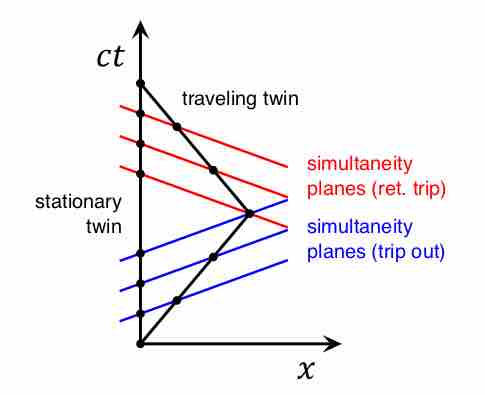The twin paradox is a thought experiment in special relativity involving identical twins, one of whom makes a journey into space in a high-speed rocket and returns home to find that the twin who remained on Earth has aged more.
This occurs because special relativity shows that the faster one travels, the slower time moves for them.
This result appears puzzling because each twin sees the other twin as traveling, and so, according to a naive application of time dilation, each should paradoxically find the other to have aged more slowly. In other words, from the perspective of the rocketship, the earth is traveling away from the ship and from the perspective of the earth, the rocket is traveling away.
However, this scenario can be resolved within the standard framework of special relativity (because the twins are not equivalent; the space twin experienced additional, asymmetrical acceleration when switching direction to return home), and therefore is not a paradox in the sense of a logical contradiction.
The Earth and the ship are not in a symmetrical relationship: regardless of whether we view the situation from the perspective of the Earth or the ship, the ship experiences additional acceleration forces. The ship has a turnaround in which it accelerates and changes direction whereas the earth does not. Since there is no symmetry, it is not paradoxical if one twin is younger than the other. Nevertheless twin paradox is useful as a demonstration that special relativity is self-consistent.
In the spacetime diagram , drawn for the reference frame of the Earth-based twin, that twin's world line coincides with the vertical axis (his position is constant in space, moving only in time). On the first leg of the trip, the second twin moves to the right (black sloped line); and on the second leg, back to the left. Blue lines show the planes of simultaneity for the traveling twin during the first leg of the journey; red lines, during the second leg. Just before turnaround, the traveling twin calculates the age of the Earth-based twin by measuring the interval along the vertical axis from the origin to the upper blue line. Just after turnaround, if he recalculates, he'll measure the interval from the origin to the lower red line. In a sense, during the U-turn the plane of simultaneity jumps from blue to red and very quickly sweeps over a large segment of the world line of the Earth-based twin. The traveling twin reckons that there has been a jump discontinuity in the age of the Earth-based twin.

Spacetime Diagram of the Twin Paradox
Spacetime diagram of the twin paradox. Time is relative, but both twins are not equivalent (the ship experiences additional acceleration to changes the direction of travel).